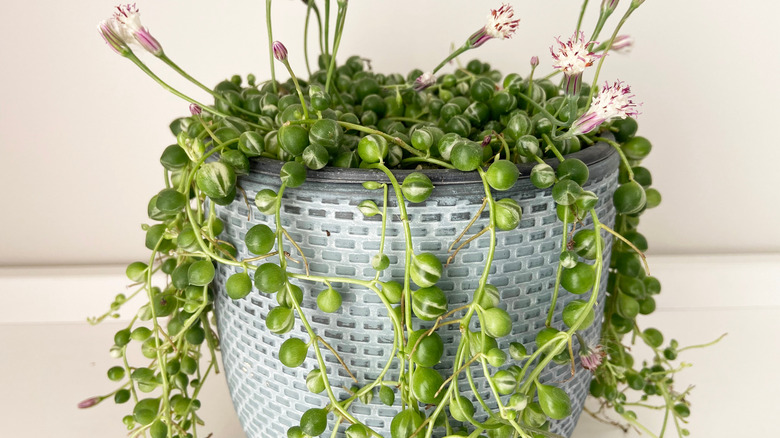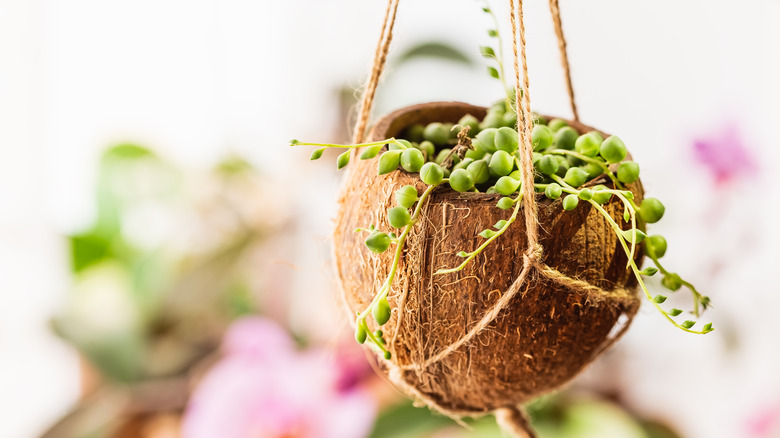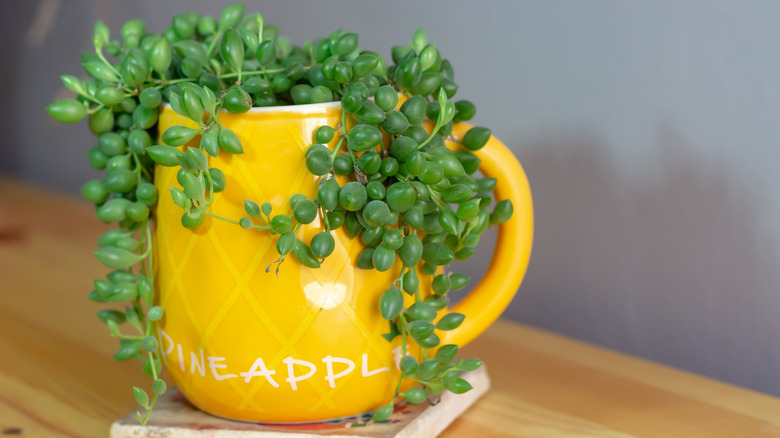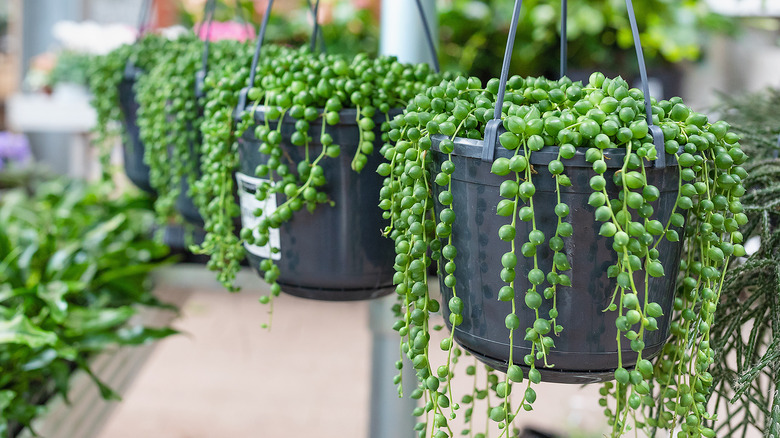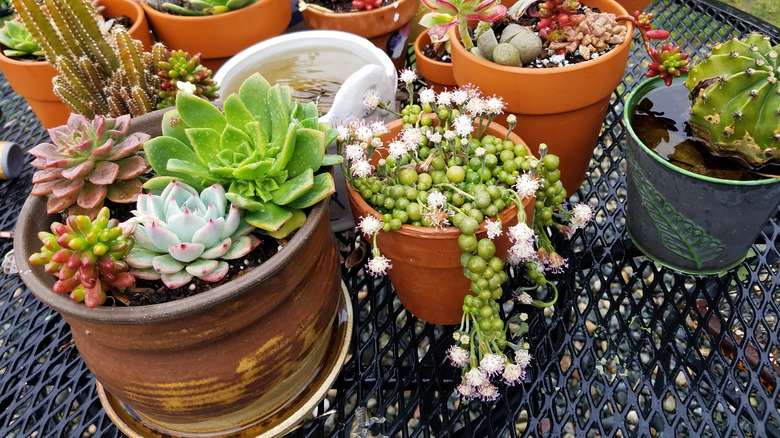How To Successfully Grow A String Of Pearls Plant
String of Pearls plants (Senecio rowleyanus) do more than catch your eyes. These succulents, sometimes referred to as String of Beads, resemble peas strung on a vine. According to The Spruce, they're natives of East Africa, where they appear in nature as cushy carpets sprawling on the ground. String of Pearls plants are distinctive, easy to grow, and in no way edible since they're toxic to animals and people alike.
These plants spread on stems that cascade over the rims of hanging baskets and planters, similar to another succulent variety: the String of Rubies plant. It is easy to imagine them nestled in the corners of some ancient palace, ennobling the homes of royalty from Southern Africa to the Mediterranean. The good news is that the String of Pearls plant also yields white flowers in spring that give off a pleasant scent, which some say smells like cinnamon.
Furthermore, it's possible to propagate a String of Pearls plant from stems since they can grow 6 to 12 inches a year. The bad news is that they will need an occasional assist from you if your goal is to reach the highest end of that spectrum.
Although they're African in origin, you'll now find these plants worldwide because they're incredibly compatible with various climates, the experts over at Gardenista maintain. They can be planted anytime and grown year-round, although they do best if started when the weather turns warm.
How to use a String of Pearls plant
String of Pearls plants are just as happy to spend time indoors as out, so the folks over at Apartment Therapy recommend them as the perfect roommate. Over time, they've become associated with early adult homesteading, as even people with busy lives can care for them.
Owners often keep these plants indoors as window accents, on bookshelves or in nooks, and between other hanging ornaments like paintings and light fixtures. They're just as popular on porches and patios where they can bask in bright, indirect light and warmth. Often, you'll find them in commercial settings like restaurants and stores because, again, given enough light and water, they can do a lot to liven up any environment.
You'll want to ensure that your String of Pearls plants take a break from the sunlight when set outdoors. They don't like to sunbathe, and even if you choose to keep them outside, ensure to bring them indoors when the temperatures start to slip below 70 degrees Fahrenheit. And once you do, remember not to set them where they'll catch a chill — say a hallway that sees a draft or too close to an air conditioner.
How to grow a String of Pearls plant
According to Gardeners' World, the best way to propagate a new String of Pearls plant is to take cuttings from another plant from spring through summer; it's healthy for the plant to be pruned anyway. Cut 4 to 5 inches below the leaf node, preferably when trimming your leafy friend. You can always return some trimmings to the container to fill out its appearance in a few days. Let the cuttings rest for 48 hours, so they'll dry where they've been cut or plucked.
Fill a pot with soil with a 3:1 ratio of sharp sand and soil-based compost — cactus compost can also work. Place the cut ends an inch deep in the center, leaving no leaves below the surface. Then backfill the plant with the compost mixture and water it for two or three days. Keep the container indoors in indirect sunlight or partial sun if you want the plant outdoors, and only water when the soil is dry because the String of Pearls plant hates overwatering.
If you're propagating by rootball, find a container that's just a tad bigger than it is, backfilling it with soil, sharp sand, and compost. Be careful with the leaves as you move them because they're delicate and easily break off. Keeping your plant cool in the winter will encourage flowers during spring, so 50 to 55 degrees is optimal.
How to care for a String of Pearls plant
Lively Root breaks down caring for String of Pearls plants with a series of simple directives. The central considerations are water, light, and temperature when growing these plants, as with many others. If you're growing your String of Pearls plant indoors, note that it will enjoy the light flowing through south and east-facing windows. Direct sunlight should come in the morning, followed by indirect afternoon light. If you're in a place that doesn't get six to eight hours of sunshine, fluorescent lights can help.
Next, make sure your String of Pearls plant gets its moisture. A decent drink every other week works, and the best way to determine if it's running dry is to check by inserting a popsicle stick or chopstick into the soil. Be careful when using your finger because brushing the plant could give you an irritating rash. If the container is dry after more than 2 inches, you'll know it's time to water.
Be generous in your watering, but ensure adequate drainage because String of Pearls plants are susceptible to root rot if overwatered. If you're using a tray to soak or drain water, ensure that the plant doesn't sit in it for more than an hour.
And finally, these little creepers like it on the warm side — think spring leading into summer. Their sweet spot is somewhere between 65 and 75 degrees, although a few plant owners like to induce premature dormancy by lowering the thermostat another 5 degrees below the plant's preference. This action can produce impressive blooms come springtime.
Varieties of String of Pearls plants
The Spruce will tell you that String of Pearls plants are just one of the many plants renowned for their cascading leaves with distinctive shapes. All are related to the dandelion, and each one has an appearance to delight, bemuse, or intrigue the viewer. They include varieties like a String of Buttons, String of Hearts, String of Turtles, and String of Nickels. Some of the more popular relatives include:
• Curio herreanus is known by the household names String of Beads or String of Watermelon. It's a trailing plant immediately identified by its spherical leaves with purple stripings, like a miniature watermelon.
• Curio radicans don't trail as much as the String of Pearls, but their tendrils, shaped like bananas, have made them a favorite. You'll also see these plants referenced as String of Bananas or fishhooks.
• Curio citriformis is a varietal that's recognized by several distinctive features. For one, the plant produces little flowers of white to cheer up the space between the end of summer and winter's onset. Additionally, its chubby leaf shape earned it the nickname String of Teardrops; its stems are unusual, too, being both trailing and erect.
How to repot a String of Pearls plant
String of Pearls plants don't require frequent repotting because they have a shallow root base, according to Joy Us Garden. But there are telltale signs of the plant needing a new home. For instance, if its development noticeably diminishes and it loses leaves, or you see roots growing out of the container, that time has come.
When selecting a new pot, ensure that you've picked one that provides adequate drainage; ceramic and terracotta are good options. The last thing you want is a plant that thrives in the desert to become waterlogged. Therefore, the best way to repot it is to ensure that the new home mimics its natural environment — a pot that's shallow, wide, and self-draining will do nicely.
Spring is the optimal time to repot. Choose a slightly larger container than the plant's current home, and if the pot doesn't drain, keep looking until you find one that does. You'll want the same mixture of sharp sand and soil-based compost or cactus compost that you've been using. Place the rootball in a hole at the center, backfill, and give the plant a nice bath once you've finished.
Succulents have an assortment of dedicated products in food and fertilizer, often identified on the packaging as "cactus and succulent" supplements. A String of Pearls plant won't need any more than a monthly helping, and one caveat: Make sure the food doesn't wind up on any leaves, as it can adversely affect your plant's health.
